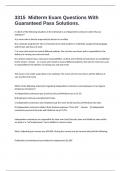3315 Midterm Exam Questions With
Guaranteed Pass Solutions.
In which of the following situations is the individual is an independent contractor rather than an
employee?
A) a nurse who is directly supervised by doctors in an office
B) a computer programmer who is instructed as to what projects to undertake, programming language
and format, and hours of work
C) a nurse who travels to several different patients. She sets her own hours and is responsible for the
delivery of nursing care and end result
D) a teacher whose hours, classroom responsibilities, content and methods of instruction are established
by the school - Answer C) a nurse who travels to several different patients. She sets her own hours and
is responsible for the delivery of nursing care and end result
This nurse is not under supervision of an employer. The nurse sets her own hours and the delivery of
care and the end result.
Which of the following statements regarding independent contractors and employees is true (ignore
temporary provisions)?
A) Independent contractors pay Social Security and Medicare tax of 15.3%.
B) Employees must pay unemployment taxes.
C) Independent contractors and employees pay the same Social Security and Medicare tax rates.
D) Independent contractors deduct their business expenses "from AGI." - Answer A) Independent
contractors pay Social Security and Medicare tax of 15.3%.
Independent contractors are responsible for their own Social Security taxes and Medicare taxes which
are paid as a "self employment" tax in addition to income taxes.
West's adjusted gross income was $90,000. During the current year he incurred and paid the following:
Publications (unreimbursed and related to employment) $2,000
,Tax return preparation fee 1,000
Dues to professional organizations 1,500
Fees for will preparation (no tax advice) 800
Life insurance premiums 1,400
Assuming he can itemize deductions, how much should West claim as miscellaneous itemized
deductions (after limitations have been applied)?
A) $2,700
B) $4,500
C) $3,500
D) $5,300 - Answer A) $2,700
The first three items are deductible—$2,000 + $1,000 + $1,500 = $4,500. The floor is $1,800 (.02 ×
$90,000), leaving a deduction of $2,700.
All of the following are allowed a "For AGI" deduction except:
A) Cora owns her own CPA firm and travels from Lafayette, LA. to Washington, D.C. to attend a tax
conference.
B) Jennifer, who lives in Houston, is the owner or several apartment buildings in Salt Lake City and travels
there to inspect and manage her investments.
C) Alan is self-employed and is away from home overnight on job-related business.
D) Alison is an employee who is required to travel to company facilities throughout the U.S. in the
conduct of her management responsibilities. She is not reimbursed by her employer. - Answer D) Alison
is an employee who is required to travel to company facilities throughout the U.S. in the conduct of her
management responsibilities. She is not reimbursed by her employer.
Unreimbursed employee business expenses are from AGI deductions, specifically, miscellaneous
itemized deductions subject to the 2% floor.
Ron is a university professor who accepts a visiting position at another university for six months and
obtains a leave of absence from his current employer. Ron rents an apartment near the university and
purchases his food. These living expenses incurred by Ron while visiting the university will be
, A) deductible for AGI.
B) deductible from AGI, without application of a floor.
C) deductible from AGI, subject to the 2% of AGI floor.
D) nondeductible. - Answer C) deductible from AGI, subject to the 2% of AGI floor.
Ron has accepted a temporary assignment of one year or less so the living expenses are deductible. He is
an employee so the deductible expenses will be subject to the 2% of AGI floor.
Gayle, a doctor with significant investments in the stock market, traveled on a cruise ship to Bermuda.
Investment specialists provided daily seminars which Gayle attended. The cost of the cruise for four days
is $2,500. Gayle can deduct (before application of any floors)
A) $0.
B) $1,250.
C) $2,000.
D) $2,500. - Answer A) $0.
None of the travel expenses are deductible because the expenses are related to income-producing
activities under Section 212 and are not related to Gayle's trade or business.
Austin incurs $3,600 for business meals while traveling for his employer, Tex, Inc. Austin is reimbursed in
full by Tex pursuant to an accountable plan. What amounts can Austin and Tex deduct?
A)
Austin Tex
$0 $1,800
B)
Austin Tex
$0 $3,600




